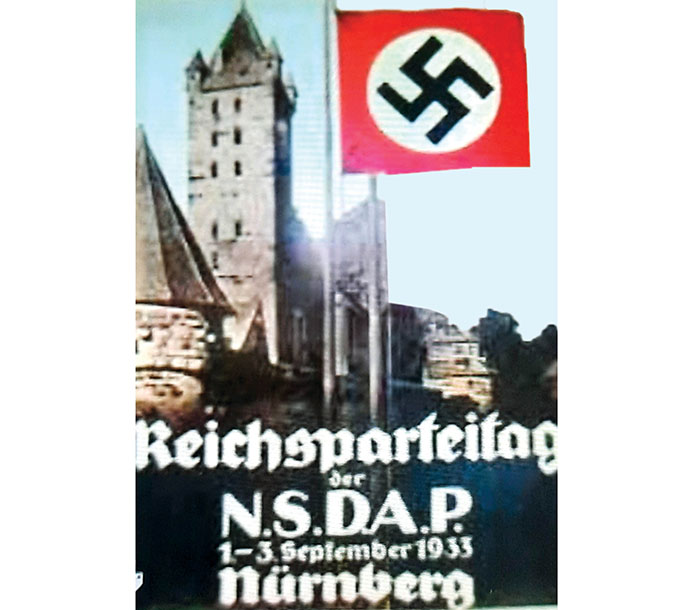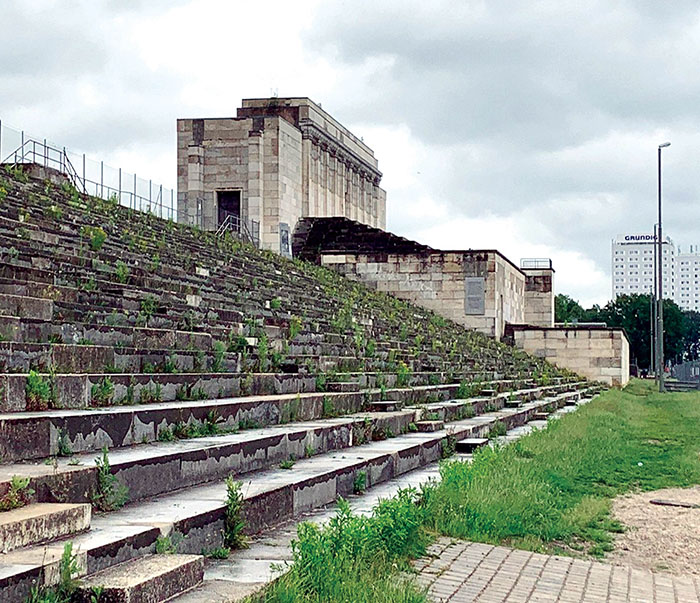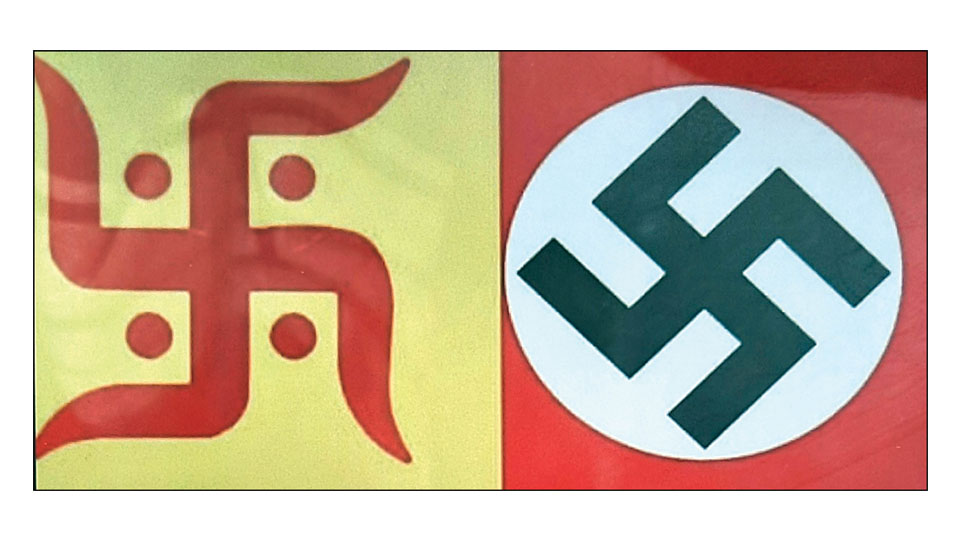By Girija Madhavan
Flowers, birds or animals are contemporary national emblems; the Royal Bengal Tiger is India’s representative animal. Indonesia honours the Komodo Dragon, the largest and fiercest lizard on earth [featured in a James Bond film, killing his armed adversary instead of Bond].
But some ancient symbols, like the Swastika, are an integral part of the Indian ethos. Stemming from the Sanskrit words “Su Asti,” or well-being, the icon is defined as a “Tetra Gammadion”, crossed lines with arms at right angles in the same rotary direction. These four extensions are variously interpreted; Yugas or ages, the four Vedas, the four stages of human life, the infinity of creation or the Sun that it represents. It is an auspicious icon in the heritage of Hinduism, Buddhism and Jainism. Its presence has been found in far-flung places in the world dating back to a misty past of over 7,000 years ago.
In Indian society, the symbol is important in festivals; as motifs in rangolis, painted on walls in bold vermilion and turmeric, inscribed in ledgers for luck. In July, when Rishi Sunak was in the running for the post of Prime Minister, Anand Mahindra humorously put out a morphed photo of No.10 Downing Street decorated with Swastikas and mango leaves. Rudyard Kipling featured the classical Swastika on his book covers to symbolise his association with India but stopped the practice shortly before his death in 1933 when the Nazi Haken Kreuz, though different from the Swastika, was becoming infamous.

The interest in the Swastika in 19th century Europe is traced to the discoveries of a German archaeologist called Heinrich Schliemann in his quest to find the legendary city of Troy. Armed with a copy of Homer’s Iliad, he went first to Greece, then to Hisarlik in Turkey where he found the site of Troy. Among his excavations, many Swastika motifs were revealed; some were of the Hooked Cross which is left-facing. The direction of its arms being counter clockwise, it is the opposite image of our serene Swastika.
Fascist regimes utilise heraldry as a potent means of communication. The Nazis replaced the old German coat of arms with the “Haken Kreuz”. It became the Nazi emblem in 1920, with Hitler himself designing the flag. The ancient migrations of Proto-Indo-Europeans were later linked to ideas of the “pure Aryan” Nazi ideology, the Haken Kreuz becoming synonymous with their racist and genocidal policies. After the Second World War, the Nazi cross was banned in Germany and many other countries.
Our last post in the Indian diplomatic service was when my husband, A. Madhavan, was posted to the Federal Republic of Germany as Ambassador in 1988. When the Second World War ended in 1945, I was seven, old enough to know Germany had lost the war. My interest in Germany was kindled by my father, M. Venkatesh. A Railway engineer in the Mysore State Railways, he was sent abroad to study advanced railway engineering. He went first to England and then to Germany in the 1930s, as the Nazi movement was taking hold which he disliked. I have his snapshots of Deutsches Eck in Koblenz [before the statue atop the monument was destroyed in World War II], of Munich and the Sebengebirge Hills on the Rhine; names already familiar I went to Bonn in 1988.

We travelled to Berlin, then a divided city, to Munich and Nuremberg, once the centre for the huge Nazi rallies, recorded by the film-maker Leni Riefenstahl in her film “Triumph Of Will”. On our visit there, we saw the arena of the rallies, reviving memories of flags and banners emblazoned with the Haken Kreuz from films and books like “The Rise and Fall of the Third Reich” by William Shirer. There, among the weeds in the tiered grand-stand where once cheering throngs stood, saluting their Fuhrer, a red scrap caught my eye; a bit of carpeting left over from Nazi days. I picked it up to take home but good sense [and a look from Madhavan!] made me put it back.
The Festivals of India brought our cultural heritage and fine artistes to Germany. On a smaller scale, the Indian Embassy, along with the Indo-German Friendship Society, also organised social events. Some elderly Germans and resident Indians were invited to attend a gathering featuring a cultural show and documentary films followed by Indian snacks. A South Indian student, Srinivasan, offered to give a Bharatanatyam recital, the highlight of the soiree.
The Tagore Institute, a music school for German and foreign students, was also represented. It was run by Mrs. Purohit, a long time resident of Bonn. A group of Afghan boys, learning tabla there, were to start the programme giving a short recital of Tala rhythms with “Bols.” The introductions were made by “Frau Soni Chopra,” a lady working in Radio Deutsche Welle, who spoke impeccable German. The young Afghans were well-received.

Frau Chopra then introduced the Bharatanatyam dancer. Srinivasan then came on stage with conventional heavy eye makeup, lipstick, bejewelled, attired in traditional Bharatanatyam costume with ankle bells…bare to the waist. The Afghan boys were a little taken aback, one could not control his titters. But the audience enjoyed the recital and gave Srinivasan a good round of applause after his first performance.
As Srinivasan had requested time to change his costume for his second item, the documentaries came next, with “Our Feathered Friends,” Indian birds. The next film depicted folk art; women composing a large flower rangoli on the floor. The camera zoomed in on the centre of the finished decoration to reveal a very large Swastika in glowing red and yellow flowers. There was a collective gasp from the audience and whispers. The film was halted at once. Srinivasan saved the day, returning in a new costume and even gave an encore. This time he danced not to a Karnatak music composition but curiously to K.L. Saigal’s emotion laden song, “Kaho Na Aas Niraas Bhayi” which translates as “Do not say Hope turns to Disappointment!” On this happy note we concluded the evening.








Recent Comments